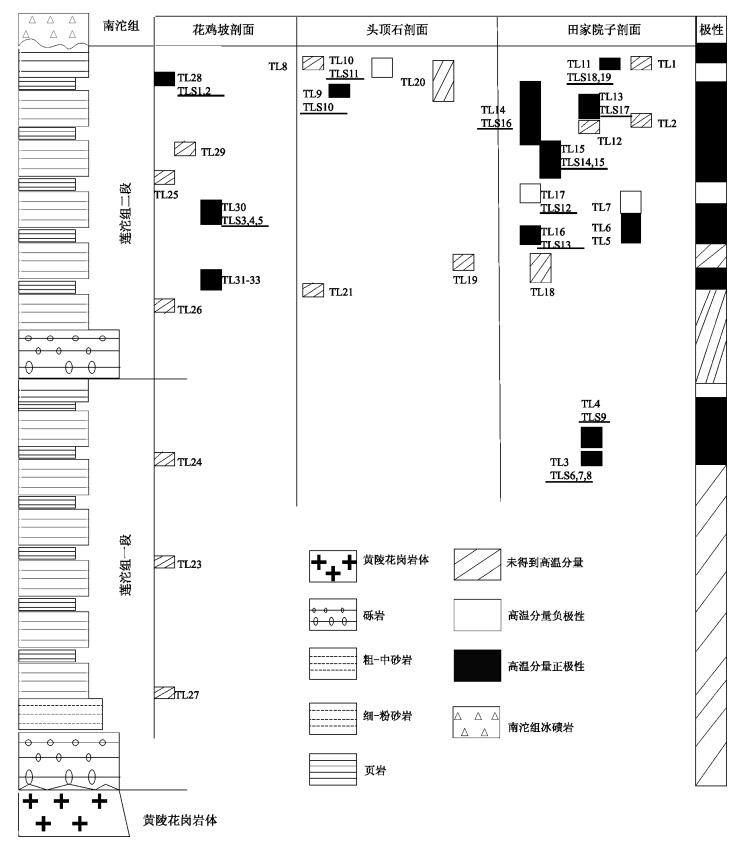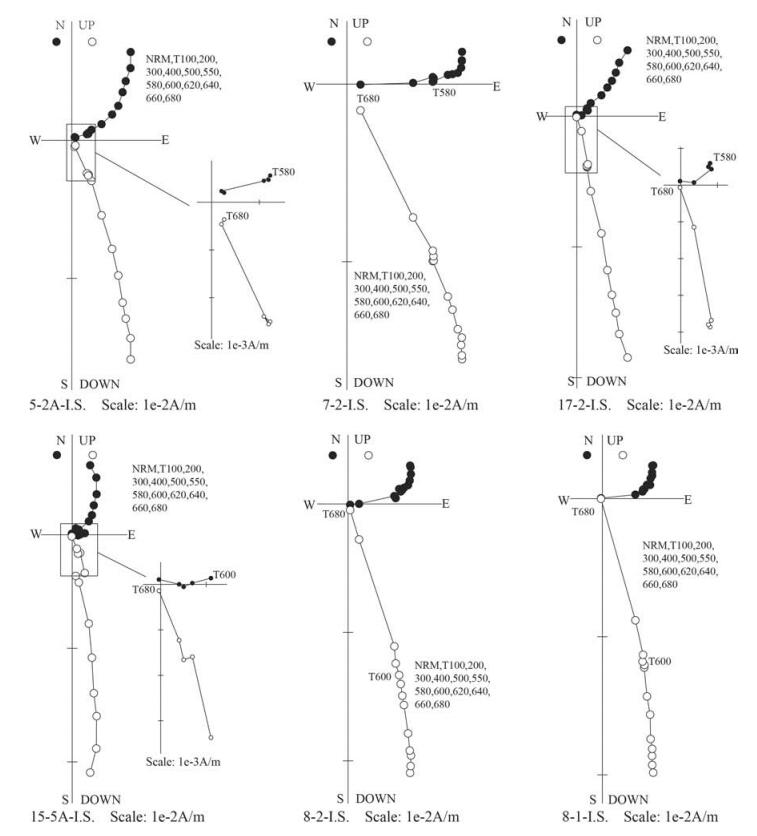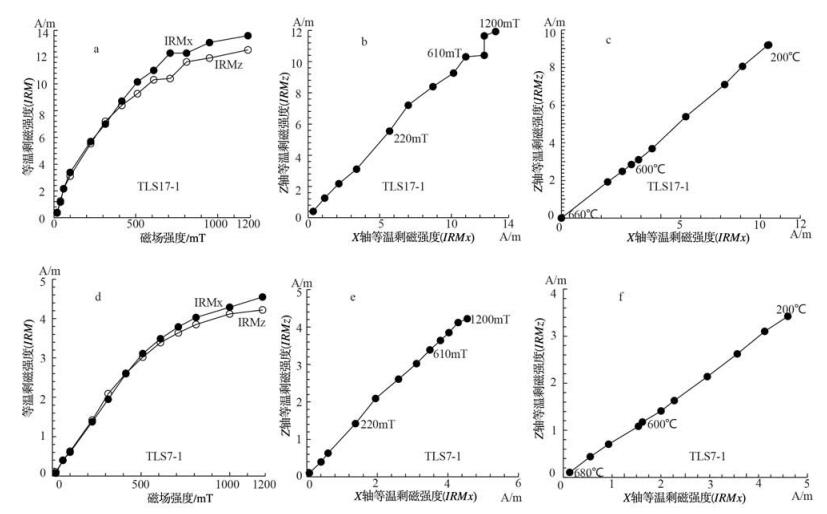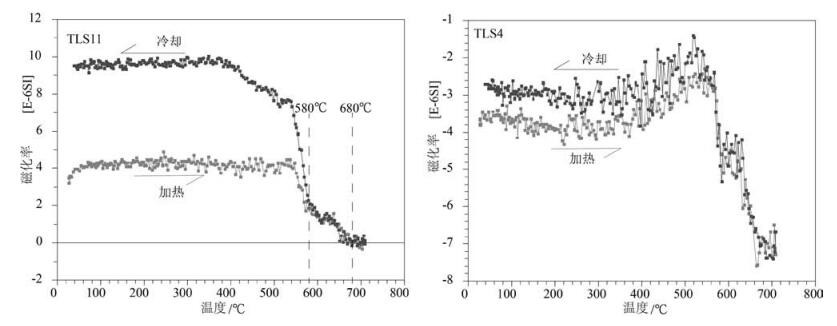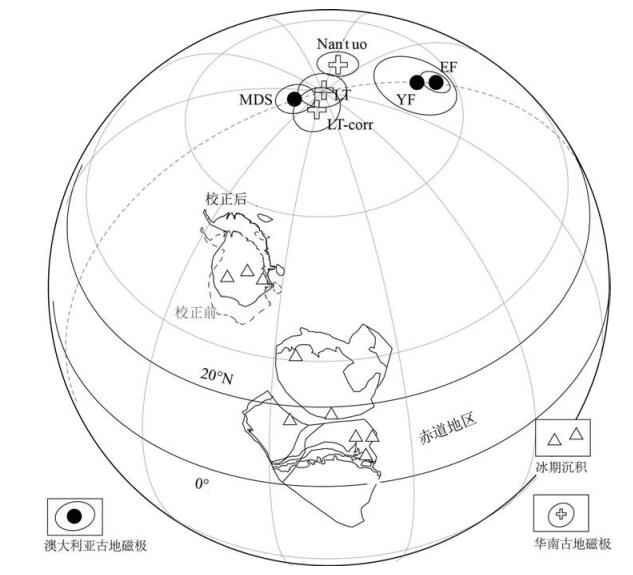Inclination shallowing study of the Early-Neoproterozoic Liantuo Formation in South China and its paleogeographic implications
-
摘要:
华南莲沱组最新的年龄结果表明,其时代结束于715Ma,因此,准确确定莲沱组的古纬度对“雪球地球”的研究具有重要意义。通过对莲沱组红层进行等温剩磁各向异性研究,获得其磁倾角校正因子为0.8719,校正后的磁倾角为70.4°,对比热退磁实验测得的莲沱组磁倾角为67.8°,则其磁倾角偏低量为2.6°。通过校正前后的磁倾角分别计算古纬度,获得磁倾角偏低所引起的古纬度变化为3.9°±6°。通过对比华南与澳大利亚-东南极板块的720Ma古地理位置,发现这一时期冰碛岩从中纬度到赤道广泛分布,验证了当时的“雪球地球”环境。
Abstract:New dating data indicate that the Liantuo Formation ended at 715Ma, and hence the constraint of the paleolatitude of the Liantuo Formation will shed a light on the "Snowball Earth" theory. Researchers have obtained reliable paleomagnetic results from the Liantuo Formation, but the inclination shallowing has not been considered by them. In this paper, the authors obtained a corrected parameter by conducting a remnant anisotropy research on Liantuo Formation. The inclination shallowing in Liantuo Formation is 2.6°, which results in a latitude difference of 3.9°±6°. The reconstruction of the South China and Australia block at 720Ma shows the diamictite distribution from middle latitude to tropical region, which proves the "Snowball Earth" theory.
-
Keywords:
- Liantuo Formation /
- inclination shallowing /
- Snowball Earth /
- Neoproterozoic
-
随着地球科学家对地球系统研究的不断深入,人们发现新元古代时地球系统发生了一系列的剧烈变化。在地球地质历史的这一时期,地球从较稳定的古-中元古代(17~7.5亿年)[1],进入剧烈变动的中-晚新元古代时期(7.5~5.4亿年)。中-晚新元古代地球上出现多期极冷事件[2-7],条带状铁矿也在消失十多亿年后,在新元古代中期又重新出现[1, 8],大洋与大气圈的氧含量快速增加[9-11]。地球系统这一系列的剧变很可能发生在Rodinia超大陆裂解的背景下。因此,重建这一时期的古地理古板块位置对于理解这些剧变至关重要。然而,由于这一时期(7.5~5.4亿年)全球不同块体古地磁数据的缺乏和可靠性问题,其古地理重建一直存在较大的争议[12-20]。
影响这一时期古地磁数据可靠性的因素,除了考虑剩磁的获得时间外,近年来越来越多的学者注意到非偶极子场及磁倾角偏低对古地磁数据的影响[21-26],特别是红层中存在普遍的磁倾角偏低现象[27-28]。
最近,Jing等[29]报道了湖北宜昌三峡地区莲沱组红层可靠的古地磁极,并根据Lan等[30]最新的SIMS锆石U-Pb定年研究,确定这一古地磁极年龄应为720Ma。虽然这一古地磁极通过了Van der Voo[31]的6项Q检验,确保其剩磁获得的原生性,但这一结果是否受到后期压实作用的影响并产生磁倾角偏低,以及影响程度的大小等问题,都需要进一步研究。在长阳地区,由于古城冰碛岩覆盖在莲沱组之上,因此准确确定莲沱组的磁倾角,对确定华南这一时期的古纬度及“雪球地球”的研究都具有重要意义。另外,目前华南地块莲沱组古地磁极与南沱组古地磁极相似的问题,一直没有得到可信的解释,本文通过磁倾角偏低的研究,对这一问题进行探讨。
1. 区域地质概况及采样
采样区位于华南新元古代地层典型剖面区,湖北三峡地区(图 1)。研究区出露的新元古代沉积地层包括莲沱组、南沱组、陡山沱组、灯影组等。莲沱组一般不整合覆盖于黄陵花岗岩之上,主要为厚层的紫红色砂岩和砾岩,可分为2个大的沉积旋回(图 2),每个旋回底部为砾石或粗粒石英砂岩,向上逐渐变为粉砂岩、泥质砂岩,含多层凝灰岩或凝灰质碎屑岩。在区域上,西北部地层厚度较大,向西南变薄。本区南沱组与莲沱组平行不整合接触或低角度不整合接触,南沱组主要为暗绿色冰碛砾岩,部分为红色冰碛岩[32]。
![]() 图 2 本次研究获取的采点(下划线标注TLS编号)在地层上的分布(TL编号为Jing等[29]采点)Figure 2. Stratigraphic column of the Liantuo Formation and detailed sampling layer positions of three sub-sections at Yichang
图 2 本次研究获取的采点(下划线标注TLS编号)在地层上的分布(TL编号为Jing等[29]采点)Figure 2. Stratigraphic column of the Liantuo Formation and detailed sampling layer positions of three sub-sections at Yichang在三峡地区南部的长阳地区,莲沱组之上覆盖古城组冰碛岩和大塘坡组页岩,而不是直接与南沱组接触[33]。古城组冰碛岩应与扬子西南部广泛发育的长安组冰碛岩一致[33],属于Sturtian冰期的产物。古城组沉积时间应始于715Ma左右[33]。
三峡地区从埃迪卡拉纪开始长期沉积碳酸盐岩,早寒武世有一次沉积间断,直到志留纪宜昌地区大规模抬升,沉积间断接受剥蚀,随后沉陷到早三叠世再次抬升[34-35]。本地区经历了3次主要的构造运动:加里东期、印支期和燕山期构造运动。同时中扬子地区存在与这3次构造运动相关的3期油气生成和排烃过程[36]。区域内构造变形较弱。
本次在宜昌花鸡坡、头顶石及田家院子3个剖面共采集了17块手标本样品(TLS1-17),对莲沱组是否存在磁倾角偏低现象进行检验(图 2)。样品在野外用罗盘测量层面的走向和倾角,并标记在层面上。
2. 实验方法
在室内用台式钻机垂直手标本层面钻取2根以上岩心,并加工出1~2块高2.2cm、直径2.5cm的标准岩心样品。每根岩心选取1~2块,共31块标准样品进行系统热退磁实验。同时对应选择了30块样品进行Hodych等[23]磁倾角偏低校正实验。所有实验工作均在中国地质科学院地质力学研究所国土资源部古地磁与古构造重建重点实验室完成。使用美国ASC Scientific Inc.公司生产的IM-10-30脉冲充磁仪对样品进行充磁,样品系统热退磁由TD-48大型热退磁仪完成,样品剩磁测量在ARGICO-JR6A旋转磁力仪上完成。另外,对部分样品利用KLY-3 Kappabridges进行了氮气环境下磁化率随温度变化实验(K-T),获取连续加热-冷却曲线分析样品磁化率的变化。
3. 实验结果
3.1 逐步热退磁结果
宜昌三峡地区花鸡坡、头顶石及田家院子剖面莲沱组样品的岩石磁学实验结果显示,岩石的特征剩磁载磁矿物为赤铁矿[29]。因此,系统热退磁温度区间在低温段以50~100℃为间隔,高温段温度区间以20℃为间隔,热退磁温度达到680℃(图 3)。样品使用主向量分析法[37]进行剩磁组分分析。
逐步热退磁结果显示,样品中共可以分离出3个剩磁方向(图 3):低温分量一般在小于等于300℃的情况下分离出来, 共有15块样品分离出此分量,其在地理坐标系下的统计方向(Dg=5.9°,Ig=60.1°,kg=81.3, ɑ95=4.3°)与采样点现代地磁场方向接近,应为现代地磁场的热粘滞剩磁;中温分量的温度区间一般在300~600~640℃之间,共有6块样品分离出此分量,其平均方向在地理坐标系下为Dg=34.5°,Ig=78.1°,kg=244.2,ɑ95=4.3°,在地层坐标系下为Ds=78.9°,Is=78.4°,ks=243.5,ɑ95=4.3°。另外,从11块样品中分离出了与宜昌剖面得到的特征分量相似的高温分量(600~680℃),其平均方向在地理坐标系下为Dg=67.0°,Ig=71.6°,kg=124.7,ɑ95=3.9°,在地层坐标系下为Ds=95.3°,Is=67.8°,ks=196.0,ɑ95=3.1°。
3.2 等温剩磁各向异性实验结果
对12个样品,在与其层面呈45°方向,从低到高逐步增加等温直流磁场,获得平行于层面IRMx和垂直于层面IRMz的等温剩磁,直流磁场大小由20、40、60、100、225、315、415、510、510、710、810、950、1200mT依次递增。在每步施加直流场后使用JR6旋转磁力仪对样品进行剩磁测试。然后用TD48大型热退磁炉对所有样品进行系统热退磁,相关数据结果列于表 1中。
表 1 宜昌地区剖面莲沱组样品等温热剩磁各向异性及磁倾角偏低值Table 1. Anisotropy of isothermal remnant magnetization for Liantuo Formation red beds in Yichang areaID Iobs IRMz/IRMx
(610~1200mT)IF1 ΔI1(=IF1-Iobs) IRMz/IRMx
(600°C以上)IF2 ΔI2(=IF2-Iobs) 15 64.4 0.7796 69.518 5.118 0.8542 67.7425 3.3425 15-2c 71.5 0.8414 74.277 2.777 0.8513 74.1009 2.6009 15-5b 65 0.899 67.256 2.256 0.8757 67.7876 2.7876 17-1 72.1 0.831 74.976 2.876 0.8118 75.3075 3.2075 3-1 73 0.87 75.105 2.105 0.8859 74.8452 1.8452 4-2b 66.3 0.6147 74.899 8.599 0.901 68.4206 2.1206 5-2b 64.2 0.8472 67.728 3.528 0.9117 66.2153 2.0153 5-4b 66 0.7989 70.420 4.420 0.872 68.7818 2.7818 7-1 61.9 0.8579 65.389 3.489 0.8731 65.0054 3.1054 8-3 70 0.8737 72.359 2.359 0.856 72.6951 2.6951 8-4 66.8 0.8701 69.548 2.748 0.8977 68.9555 2.1555 平均值 67.8 0.8258 71.377 3.577 0.8719 70.4146 2.6146 注:ID为样品号,Iobs为热退磁实验所得样品磁倾角,IRMz/IRMx(610~1200mT)为610~1200mT之间垂直层面方向和平行层面方向等温剩磁大小的比值,IRMz/IRMx(600°C以上)为600 °C以上垂直层面方向和平行层面方向等温剩磁大小的比值,IF为校正后磁倾角,ΔI为校正值 考虑到实验过程中样品的等温剩磁方向可能受天然剩磁的影响,以及载磁矿物主要为赤铁矿,所以施加外部直流场在200~1200mT之间及系统热退磁温度在600~680℃之间的IRMz/IRMx拟合线反映了赤铁矿的剩磁各向异性特征。
由于垂直于层面的IRMz值大部分在500mT之后略小于平行于层面的IRMx值(图 4-a、d),所以从磁场强度方面考虑,选取在500mT之后的610~1200mT区间的IRMz/IRMx拟合线的斜率作为磁倾角偏低校正因子,其大小为0.8258,对应的沉积压实为18%。另外,从热退磁的方面考虑,选取600~680℃区间的IRMz/IRMx热退磁结果拟合线的斜率作为磁倾角偏低校正因子,其大小为0.8719,对应的沉积压实为13%。利用公式IRMz/ IRMx=tan (Iobs)/tan (IF)进行校正后得到莲沱组磁倾角分别为71.4°和70.4°,两者的磁倾角值差别不大。
![]() 图 4 45°方向加场后平行于层面方向(IRMx)和垂直于层面方向(IRMz)等温剩磁获得曲线图(a, d),IRMz/IRMx关系图(b, e)和IRMz/IRMx的热退磁结果(c, f)Figure 4. Plots of IRMx (parallel to bedding) and IRMz (perpendicular to bedding) acquisitions produced by applying magnetic field at 45° to bedding as function of increasing field (a, d), plots of IRMZ/IRMX(b, e), the thermal demagnetization results of IRMZ/IRMX(c, f)
图 4 45°方向加场后平行于层面方向(IRMx)和垂直于层面方向(IRMz)等温剩磁获得曲线图(a, d),IRMz/IRMx关系图(b, e)和IRMz/IRMx的热退磁结果(c, f)Figure 4. Plots of IRMx (parallel to bedding) and IRMz (perpendicular to bedding) acquisitions produced by applying magnetic field at 45° to bedding as function of increasing field (a, d), plots of IRMZ/IRMX(b, e), the thermal demagnetization results of IRMZ/IRMX(c, f)3.3 岩石磁学实验结果
为了排除样品在加热过程中可能存在的磁性矿物的变化,对几个代表性样品进行了磁化率随温度变化实验(K-T,图 5)。结果表明,部分样品在加热和冷却过程中样品磁化率明显不同(图 5,TLS11),可能是因为样品在加热过程中生成了一部分磁铁矿。但580~680℃之间的加热曲线与冷却曲线一致,表明加热过程中磁性矿物的变化并未影响到样品中赤铁矿的剩磁变化(图 5,TLS11),因此,不影响磁倾角偏低实验的结果。另一部分样品的K-T曲线显示,在加热与冷却过程中,样品的磁化率没有明显的差异,因此样品中不存在明显的磁性矿物的改变(图 5,TLS4)。
由于加热过程并未影响到高温分量载磁性矿物赤铁矿,再考虑到赤铁矿较大的矫顽力,因此,选用600~680℃区间的IRMz/IRMx值作为磁倾角偏低校正因子,利用公式IRMz/IRMx=tan (Iobs)/tan(IF)计算得到校正后的莲沱组磁倾角大小为70.4°,与热退磁实验所得莲沱组磁倾角67.8°比较,莲沱组的磁倾角偏低大小为2.6°。
4. 磁倾角偏低对莲沱组古纬度及古地磁极的影响
利用本研究得到的莲沱组磁倾角偏低校正因子,对Jing等[29]所得高温分量进行磁倾角偏低校正,利用校正后的高温分量求得的三峡地区莲沱组沉积古纬度为47.7°±5.1°,比校正前的43.7°±4.8°向高纬度地区运动了3.9°±6°。
校正后古地磁极(LT-corr)为14.7°N, 153.9°E, dp/dm=4.9/6.0,与未校正的莲沱组古地磁极(LT:12.7°N,157.4°E,dp/dm=4.5/5.8)相比更偏西北。虽然校正前后,莲沱组古地磁极在统计分析上不能显著区分,但校正后的莲沱组古地磁极与现有华南南沱组古地磁极(Nantuo)[38]明显不同(图 6)。
5. 讨论
由于Evans等[39]得到的莲沱组古地磁极与南沱组古地磁极重合,使得一些学者认为莲沱组古地磁结果可能比以前认为的更年轻[40],或是南沱期重磁化的结果。然而,Jing等[29]对宜昌莲沱组的古地磁研究表明,莲沱组中下部到顶部至少存在5个正负极性时,因此现有的莲沱组古地磁结果应该不是重磁化的结果。另外,Jing等[29]通过总结前人在三峡地区对莲沱组大量的定年结果[41-45],认为现有华南莲沱组古地磁极年龄应在720Ma左右,比之前认为的750Ma年轻,但仍老于635Ma的南沱组古地磁结果。
Jing等[29]得到的莲沱组古地磁极与南沱组古地磁极相差不大。Yang等[46]认为,莲沱组采样区可能发生过局部构造旋转作用;Zhang等[38]则认为,没有证据表明莲沱组采样区发生过局部旋转。
排除以上各方面的影响因素,笔者认为,造成莲沱组与南沱组古地磁极相似的原因应该与莲沱组岩石受压实作用影响、发生微弱的磁倾角偏低现象有关。由于目前未对南沱组取得高温分量的古地磁样品进行磁倾角偏低实验,两者真实的差别还不能确定,需要进一步研究。
经磁倾角偏低校正后的华南板块在720Ma时应位于中纬度地区(图 6)。这一时期扬子地块多处发育冰碛岩沉积,从该时期华南板块上发育的冰碛岩分布看[40],当时整个地球应处于较寒冷的气候阶段。但由于这一时期华南板块位于中纬度地区,对于地球这一时期是否处于“雪球地球”的环境,仅从莲沱组的古地磁结果不能做出明确的判定。
为此,笔者重建了华南板块及与华南关系较紧密的澳大利亚-东南极板块720Ma的古地理位置(图 6)。图 6中,将莲沱组古地磁极通过欧拉极(34.4°N、100°E,98.6°)旋转到地理北极。MDS、YF及EF分别为澳大利亚755Ma,640Ma和635Ma古地磁极[22, 47-48],位于同一大圆弧上(虚线),利用内插法求出其720Ma的古地磁极位置,通过欧拉极(-0.4°N、53.7°E,44.1°)旋转使其与莲沱组古地磁极重合。通过这一古地理重建,可以清楚地看到,这一时期有大量冰川从中纬度地区一直延续到赤道地区。这一证据直接证明,当时地球处于“雪球地球”的环境。
6. 结论
对华南三峡地区莲沱组的等温剩磁各向异性研究表明,通过磁倾角偏低校正后的莲沱组古地磁极与南沱组古地磁极存在明显差别,这表明造成莲沱组与南沱组古地磁极相似的一个重要原因是地层压实引起的磁倾角偏低。利用720Ma古地磁数据对华南和澳大利亚进行古地理重建,并对比这一时期冰碛岩的分布,结果表明,当时地球确实处于“雪球地球”的环境中。
致谢: 审稿专家对本文进行了认真细致的审阅,并提出了宝贵的修改意见,在此表示衷心的感谢。 -
图 2 本次研究获取的采点(下划线标注TLS编号)在地层上的分布
(TL编号为Jing等[29]采点)
Figure 2. Stratigraphic column of the Liantuo Formation and detailed sampling layer positions of three sub-sections at Yichang
图 4 45°方向加场后平行于层面方向(IRMx)和垂直于层面方向(IRMz)等温剩磁获得曲线图(a, d),IRMz/IRMx关系图(b, e)和IRMz/IRMx的热退磁结果(c, f)
Figure 4. Plots of IRMx (parallel to bedding) and IRMz (perpendicular to bedding) acquisitions produced by applying magnetic field at 45° to bedding as function of increasing field (a, d), plots of IRMZ/IRMX(b, e), the thermal demagnetization results of IRMZ/IRMX(c, f)
表 1 宜昌地区剖面莲沱组样品等温热剩磁各向异性及磁倾角偏低值
Table 1 Anisotropy of isothermal remnant magnetization for Liantuo Formation red beds in Yichang area
ID Iobs IRMz/IRMx
(610~1200mT)IF1 ΔI1(=IF1-Iobs) IRMz/IRMx
(600°C以上)IF2 ΔI2(=IF2-Iobs) 15 64.4 0.7796 69.518 5.118 0.8542 67.7425 3.3425 15-2c 71.5 0.8414 74.277 2.777 0.8513 74.1009 2.6009 15-5b 65 0.899 67.256 2.256 0.8757 67.7876 2.7876 17-1 72.1 0.831 74.976 2.876 0.8118 75.3075 3.2075 3-1 73 0.87 75.105 2.105 0.8859 74.8452 1.8452 4-2b 66.3 0.6147 74.899 8.599 0.901 68.4206 2.1206 5-2b 64.2 0.8472 67.728 3.528 0.9117 66.2153 2.0153 5-4b 66 0.7989 70.420 4.420 0.872 68.7818 2.7818 7-1 61.9 0.8579 65.389 3.489 0.8731 65.0054 3.1054 8-3 70 0.8737 72.359 2.359 0.856 72.6951 2.6951 8-4 66.8 0.8701 69.548 2.748 0.8977 68.9555 2.1555 平均值 67.8 0.8258 71.377 3.577 0.8719 70.4146 2.6146 注:ID为样品号,Iobs为热退磁实验所得样品磁倾角,IRMz/IRMx(610~1200mT)为610~1200mT之间垂直层面方向和平行层面方向等温剩磁大小的比值,IRMz/IRMx(600°C以上)为600 °C以上垂直层面方向和平行层面方向等温剩磁大小的比值,IF为校正后磁倾角,ΔI为校正值 -
Cawood P A, Hawkesworth C J. Earth's middle age[J]. Geology, 2014, 42(6):503-506. doi: 10.1130/G35402.1 Cawood P A, Hawkesworth C J. Earth's middle age[J]. Geology, 2014, 42(6):503-506. doi: 10.1130/G35402.1
Kirschvink J L. Late Proterozoic low-latitude global glaciation:the snowball Earth[C]//The Proterozoic biosphere:a multidisciplinary study. Cambridge University Press, New York, 1992:51-52. Kirschvink J L. Late Proterozoic low-latitude global glaciation:the snowball Earth[C]//The Proterozoic biosphere:a multidisciplinary study. Cambridge University Press, New York, 1992:51-52.
Hoffman P F, Kaufman A J, Halverson G P, et al. A Neoproterozoic snowball earth[J]. Science, 1998, 281(5381):1342-1346. doi: 10.1126/science.281.5381.1342 Hoffman P F, Kaufman A J, Halverson G P, et al. A Neoproterozoic snowball earth[J]. Science, 1998, 281(5381):1342-1346. doi: 10.1126/science.281.5381.1342
Hyde W T, Crowley T J, Baum S K, et al. Neoproterozoic ‘snowball Earth’ simulations with a coupled climate/ice-sheet model[J]. Nature, 2000, 405(6785):425-429. doi: 10.1038/35013005 Hyde W T, Crowley T J, Baum S K, et al. Neoproterozoic 'snowball Earth' simulations with a coupled climate/ice-sheet model[J]. Nature, 2000, 405(6785):425-429. doi: 10.1038/35013005
Eyles N. Earth's glacial record and its tectonic setting[J]. Earth-Science Reviews, 1993, 35(1/2):1-248. Eyles N. Earth's glacial record and its tectonic setting[J]. Earth-Science Reviews, 1993, 35(1/2):1-248.
Harland W B. Critical evidence for a great infra-Cambrian glaciation[J]. Geologische Rundschau, 1964, 54(1):45-61. doi: 10.1007/BF01821169 Harland W B. Critical evidence for a great infra-Cambrian glaciation[J]. Geologische Rundschau, 1964, 54(1):45-61. doi: 10.1007/BF01821169
Cox G M, Halverson G P, Stevenson R K, et al. Continental flood basalt weathering as a trigger for Neoproterozoic Snowball Earth[J]. Earth and Planetary Science Letters, 2016, 446:89-99. doi: 10.1016/j.epsl.2016.04.016 Cox G M, Halverson G P, Stevenson R K, et al. Continental flood basalt weathering as a trigger for Neoproterozoic Snowball Earth[J]. Earth and Planetary Science Letters, 2016, 446:89-99. doi: 10.1016/j.epsl.2016.04.016
Klein C, Beukes N J. Sedimentology and geochemistry of the glaciogenic late Proterozoic Rapitan iron-formation in Canada[J]. Economic Geology, 1993, 88(3):542-565. doi: 10.2113/gsecongeo.88.3.542 Klein C, Beukes N J. Sedimentology and geochemistry of the glaciogenic late Proterozoic Rapitan iron-formation in Canada[J]. Economic Geology, 1993, 88(3):542-565. doi: 10.2113/gsecongeo.88.3.542
Canfield D E, Poulton S W, Narbonne G M. Late-Neoproterozoic deep-ocean oxygenation and the rise of animal life[J]. Science, 2007, 315(5808):92-95. doi: 10.1126/science.1135013 Canfield D E, Poulton S W, Narbonne G M. Late-Neoproterozoic deep-ocean oxygenation and the rise of animal life[J]. Science, 2007, 315(5808):92-95. doi: 10.1126/science.1135013
Scott C, Lyons T W, Bekker A, et al. Tracing the stepwise oxygenation of the Proterozoic ocean[J]. Nature, 2008, 452(7186):456-459. doi: 10.1038/nature06811 Scott C, Lyons T W, Bekker A, et al. Tracing the stepwise oxygenation of the Proterozoic ocean[J]. Nature, 2008, 452(7186):456-459. doi: 10.1038/nature06811
Chen X, Ling H F, Vance D, et al. Rise to modern levels of ocean oxygenation coincided with the Cambrian radiation of animals[J]. Nature Communications, 2015, 6:7142-7148. doi: 10.1038/ncomms8142 Chen X, Ling H F, Vance D, et al. Rise to modern levels of ocean oxygenation coincided with the Cambrian radiation of animals[J]. Nature Communications, 2015, 6:7142-7148. doi: 10.1038/ncomms8142
Moores E M. Southwest US-East Antarctic (SWEAT) connection:a hypothesis[J]. Geology, 1991, 19(5):425-428. doi: 10.1130/0091-7613(1991)019<0425:SUSEAS>2.3.CO;2 Moores E M. Southwest US-East Antarctic (SWEAT) connection:a hypothesis[J]. Geology, 1991, 19(5):425-428. doi: 10.1130/0091-7613(1991)019<0425:SUSEAS>2.3.CO;2
Dalziel I W D. Pacific margins of Laurentia and East AntarcticaAustralia as a conjugate rift pair:Evidence and implications for an Eocambrian supercontinent[J]. Geology, 1991, 19(6):598-601. doi: 10.1130/0091-7613(1991)019<0598:PMOLAE>2.3.CO;2 Dalziel I W D. Pacific margins of Laurentia and East AntarcticaAustralia as a conjugate rift pair:Evidence and implications for an Eocambrian supercontinent[J]. Geology, 1991, 19(6):598-601. doi: 10.1130/0091-7613(1991)019<0598:PMOLAE>2.3.CO;2
Hoffman P F. Did the breakout of Laurentia turn Gondwanaland inside-out[J]. Science, 1991, 252(5011):1409-1412. doi: 10.1126/science.252.5011.1409 Hoffman P F. Did the breakout of Laurentia turn Gondwanaland inside-out[J]. Science, 1991, 252(5011):1409-1412. doi: 10.1126/science.252.5011.1409
Li Z X, Zhang L, Powell C M A. South China in Rodinia:part of the missing link between Australia-East Antarctica and Laurentia?[J]. Geology, 1995, 23(5):407-410. doi: 10.1130/0091-7613(1995)023<0407:SCIRPO>2.3.CO;2 Li Z X, Zhang L, Powell C M A. South China in Rodinia:part of the missing link between Australia-East Antarctica and Laurentia?[J]. Geology, 1995, 23(5):407-410. doi: 10.1130/0091-7613(1995)023<0407:SCIRPO>2.3.CO;2
Li Z X, Bogdanova S V, Collins A S, et al. Assembly, configuration, and break-up history of Rodinia:a synthesis[J]. Precambrian Research, 2008, 160(1):179-210. Li Z X, Bogdanova S V, Collins A S, et al. Assembly, configuration, and break-up history of Rodinia:a synthesis[J]. Precambrian Research, 2008, 160(1):179-210.
Karlstrom K E, Williams M L, McLelland J, et al. Refining Rodinia:geologic evidence for the Australia-Western US connection in the Proterozoic[J]. GSA Today, 1999, 9(10):1-7. Karlstrom K E, Williams M L, McLelland J, et al. Refining Rodinia:geologic evidence for the Australia-Western US connection in the Proterozoic[J]. GSA Today, 1999, 9(10):1-7.
Burrett C, Berry R. Proterozoic Australia-Western United States (AUSWUS) fit between Laurentia and Australia[J]. Geology, 2000, 28(2):103-106. doi: 10.1130/0091-7613(2000)28<103:PAUSAF>2.0.CO;2 Burrett C, Berry R. Proterozoic Australia-Western United States (AUSWUS) fit between Laurentia and Australia[J]. Geology, 2000, 28(2):103-106. doi: 10.1130/0091-7613(2000)28<103:PAUSAF>2.0.CO;2
Wingate M T D, Pisarevsky S A, Evans D A D. Rodinia connections between Australia and Laurentia:no SWEAT, no AUSWUS?[J]. Terra Nova, 2002, 14(2):121-128. doi: 10.1046/j.1365-3121.2002.00401.x Wingate M T D, Pisarevsky S A, Evans D A D. Rodinia connections between Australia and Laurentia:no SWEAT, no AUSWUS?[J]. Terra Nova, 2002, 14(2):121-128. doi: 10.1046/j.1365-3121.2002.00401.x
Evans D A D. The palaeomagnetically viable, long-lived and allinclusive Rodinia supercontinent reconstruction[J]. Geological Society, London, Special Publications, 2009, 327(1):371-404. doi: 10.1144/SP327.16 Evans D A D. The palaeomagnetically viable, long-lived and allinclusive Rodinia supercontinent reconstruction[J]. Geological Society, London, Special Publications, 2009, 327(1):371-404. doi: 10.1144/SP327.16
Abrajevitch A, Van der Voo R. Incompatible Ediacaran paleomagnetic directions suggest an equatorial geomagnetic dipole hypothesis[J]. Earth and Planetary Science Letters, 2010, 293(1):164-170. Abrajevitch A, Van der Voo R. Incompatible Ediacaran paleomagnetic directions suggest an equatorial geomagnetic dipole hypothesis[J]. Earth and Planetary Science Letters, 2010, 293(1):164-170.
Schmidt P W, Williams G E, McWilliams M O. Palaeomagnetism and magnetic anisotropy of late Neoproterozoic strata, South Australia:Implications for the palaeolatitude of late Cryogenian glaciation, cap carbonate and the Ediacaran System[J]. Precambrian Research, 2009, 174(1):35-52. Schmidt P W, Williams G E, McWilliams M O. Palaeomagnetism and magnetic anisotropy of late Neoproterozoic strata, South Australia:Implications for the palaeolatitude of late Cryogenian glaciation, cap carbonate and the Ediacaran System[J]. Precambrian Research, 2009, 174(1):35-52.
Hodych J P, Buchan K L. Early Silurian palaeolatitude of the Springdale Group redbeds of central Newfoundland:a palaeomagnetic determination with a remanence anisotropy test for inclination error[J]. Geophysical Journal International, 1994, 117(3):640-652. doi: 10.1111/gji.1994.117.issue-3 Hodych J P, Buchan K L. Early Silurian palaeolatitude of the Springdale Group redbeds of central Newfoundland:a palaeomagnetic determination with a remanence anisotropy test for inclination error[J]. Geophysical Journal International, 1994, 117(3):640-652. doi: 10.1111/gji.1994.117.issue-3
Tauxe L, Kent D V. A simplified statistical model for the geomagnetic field and the detection of shallow bias in paleomagnetic inclinations:was the ancient magnetic field dipolar?[J]. Timescales of the Paleomagnetic Field, 2004:101-115. Tauxe L, Kent D V. A simplified statistical model for the geomagnetic field and the detection of shallow bias in paleomagnetic inclinations:was the ancient magnetic field dipolar?[J]. Timescales of the Paleomagnetic Field, 2004:101-115.
Wang B, Yang Z. Late Cretaceous paleomagnetic results from southeastern China, and their geological implication[J]. Earth and Planetary Science Letters, 2007, 258(1):315-333. Wang B, Yang Z. Late Cretaceous paleomagnetic results from southeastern China, and their geological implication[J]. Earth and Planetary Science Letters, 2007, 258(1):315-333.
方大钧, 谈晓冬.等温剩磁各向异性及其在磁倾角校正中的应用[J].地球物理学报, 2000, 43(5):719-724. http://www.cnki.com.cn/Article/CJFDTOTAL-DQWX200005015.htm 王恒, 仝亚博, 高亮, 等.青藏高原东南缘川滇地块古近纪沉积地层古地磁分析及其构造意义[J].地质通报, 2015, 34(1):45-57. http://dzhtb.cgs.cn/ch/reader/view_abstract.aspx?file_no=20150107&flag=1 Gilder S, Chen Y, Cogné J P, et al. Paleomagnetism of Upper Jurassic to Lower Cretaceous volcanic and sedimentary rocks from the western Tarim Basin and implications for inclination shallowing and absolute dating of the M-0(ISEA?) chron[J]. Earth and Planetary Science Letters, 2003, 206(3):587-600. Gilder S, Chen Y, Cogné J P, et al. Paleomagnetism of Upper Jurassic to Lower Cretaceous volcanic and sedimentary rocks from the western Tarim Basin and implications for inclination shallowing and absolute dating of the M-0(ISEA?) chron[J]. Earth and Planetary Science Letters, 2003, 206(3):587-600.
Jing X, Yang Z, Tong Y, et al. A revised paleomagnetic pole from the mid-Neoproterozoic Liantuo Formation in the Yangtze block and its paleogeographic implications[J]. Precambrian Research, 2015, 268:194-211. doi: 10.1016/j.precamres.2015.07.007 Jing X, Yang Z, Tong Y, et al. A revised paleomagnetic pole from the mid-Neoproterozoic Liantuo Formation in the Yangtze block and its paleogeographic implications[J]. Precambrian Research, 2015, 268:194-211. doi: 10.1016/j.precamres.2015.07.007
Lan Z, Li X H, Zhu M, et al. Revisiting the Liantuo Formation in Yangtze Block, South China:SIMS U-Pb zircon age constraints and regional and global significance[J]. Precambrian Research, 2015, 263:123-141. doi: 10.1016/j.precamres.2015.03.012 Lan Z, Li X H, Zhu M, et al. Revisiting the Liantuo Formation in Yangtze Block, South China:SIMS U-Pb zircon age constraints and regional and global significance[J]. Precambrian Research, 2015, 263:123-141. doi: 10.1016/j.precamres.2015.03.012
Van der Voo R. The reliability of paleomagnetic data[J]. Tectonophysics, 1990, 184(1):1-9. doi: 10.1016/0040-1951(90)90116-P Van der Voo R. The reliability of paleomagnetic data[J]. Tectonophysics, 1990, 184(1):1-9. doi: 10.1016/0040-1951(90)90116-P
安志辉, 童金南, 叶琴, 等.峡东青林口地区新元古代地层序列及沉积演变[J].地球科学(中国地质大学学报), 2014, 39(7):795-806. http://www.cnki.com.cn/Article/CJFDTOTAL-DQKX201407003.htm Liu P, Li X, Chen S, et al. New SIMS U-Pb zircon age and its constraint on the beginning of the Nantuo glaciation[J]. Science Bulletin, 2015, 60(10):958-963. doi: 10.1007/s11434-015-0790-3 Liu P, Li X, Chen S, et al. New SIMS U-Pb zircon age and its constraint on the beginning of the Nantuo glaciation[J]. Science Bulletin, 2015, 60(10):958-963. doi: 10.1007/s11434-015-0790-3
Peters K E, Cunningham A E, Walters C C, et al. Petroleum systems in the Jiangling-Dangyang area, Jianghan basin, China[J]. Organic Geochemistry, 1996, 24(10):1035-1060. Peters K E, Cunningham A E, Walters C C, et al. Petroleum systems in the Jiangling-Dangyang area, Jianghan basin, China[J]. Organic Geochemistry, 1996, 24(10):1035-1060.
Vernhet E, Reijmer J J G. Sedimentary evolution of the Ediacaran Yangtze platform shelf (Hubei and Hunan provinces, Central China)[J]. Sedimentary Geology, 2010, 225(3):99-115. Vernhet E, Reijmer J J G. Sedimentary evolution of the Ediacaran Yangtze platform shelf (Hubei and Hunan provinces, Central China)[J]. Sedimentary Geology, 2010, 225(3):99-115.
Zhu G, Wang T, Xie Z, et al. Giant gas discovery in the Precambrian deeply buried reservoirs in the Sichuan Basin, China:implications for gas exploration in old cratonic basins[J]. Precambrian Research, 2015, 262:45-66. doi: 10.1016/j.precamres.2015.02.023 Zhu G, Wang T, Xie Z, et al. Giant gas discovery in the Precambrian deeply buried reservoirs in the Sichuan Basin, China:implications for gas exploration in old cratonic basins[J]. Precambrian Research, 2015, 262:45-66. doi: 10.1016/j.precamres.2015.02.023
Kirschvink J L. The least-squares line and plane and the analysis of palaeomagnetic data[J]. Geophysical Journal International, 1980, 62(3):699-718. doi: 10.1111/gji.1980.62.issue-3 Kirschvink J L. The least-squares line and plane and the analysis of palaeomagnetic data[J]. Geophysical Journal International, 1980, 62(3):699-718. doi: 10.1111/gji.1980.62.issue-3
Zhang S, Evans D A D, Li H, et al. Paleomagnetism of the late Cryogenian Nantuo Formation and paleogeographic implications for the South China Block[J]. Journal of Asian Earth Sciences, 2013, 72:164-177. doi: 10.1016/j.jseaes.2012.11.022 Zhang S, Evans D A D, Li H, et al. Paleomagnetism of the late Cryogenian Nantuo Formation and paleogeographic implications for the South China Block[J]. Journal of Asian Earth Sciences, 2013, 72:164-177. doi: 10.1016/j.jseaes.2012.11.022
Evans D A D, Li Z X, Kirschvink J L, et al. A high-quality midNeoproterozoic paleomagnetic pole from South China, with implications for ice ages and the breakup configuration of Rodinia[J]. Precambrian Research, 2000, 100(1):313-334. Evans D A D, Li Z X, Kirschvink J L, et al. A high-quality midNeoproterozoic paleomagnetic pole from South China, with implications for ice ages and the breakup configuration of Rodinia[J]. Precambrian Research, 2000, 100(1):313-334.
Li Z X, Evans D A D, Halverson G P. Neoproterozoic glaciations in a revised global palaeogeography from the breakup of Rodinia to the assembly of Gondwanaland[J]. Sedimentary Geology, 2013, 294:219-232. doi: 10.1016/j.sedgeo.2013.05.016 Li Z X, Evans D A D, Halverson G P. Neoproterozoic glaciations in a revised global palaeogeography from the breakup of Rodinia to the assembly of Gondwanaland[J]. Sedimentary Geology, 2013, 294:219-232. doi: 10.1016/j.sedgeo.2013.05.016
Liu X, Gao S, Diwu C, et al. Precambrian crustal growth of Yangtze Craton as revealed by detrital zircon studies[J]. American Journal of Science, 2008, 308(4):421-468. doi: 10.2475/04.2008.02 Liu X, Gao S, Diwu C, et al. Precambrian crustal growth of Yangtze Craton as revealed by detrital zircon studies[J]. American Journal of Science, 2008, 308(4):421-468. doi: 10.2475/04.2008.02
马国干, 李华芹, 张自超.华南地区震旦纪时限范围的研究[J].中国地质科学院宜昌地质矿产研究所所刊, 1984, 8(1):1-29. http://cpfd.cnki.com.cn/Article/CPFDTOTAL-ZGDJ198412001003.htm Cui X, Zhu W B, Ge R F. Provenance and Crustal Evolution of the Northern Yangtze Block Revealed by Detrital Zircons from Neoproterozoic-Early Paleozoic Sedimentary Rocks in the Yangtze Gorges Area, South China[J]. The Journal of Geology, 2014, 122(2):217-235. doi: 10.1086/674801 Cui X, Zhu W B, Ge R F. Provenance and Crustal Evolution of the Northern Yangtze Block Revealed by Detrital Zircons from Neoproterozoic-Early Paleozoic Sedimentary Rocks in the Yangtze Gorges Area, South China[J]. The Journal of Geology, 2014, 122(2):217-235. doi: 10.1086/674801
高维, 张传恒.长江三峡黄陵花岗岩与莲沱组凝灰岩的锆石SHRIMP U-Pb年龄及其构造地层意义[J].地质通报, 2009, 28:45-50. http://dzhtb.cgs.cn/ch/reader/view_abstract.aspx?flag=1&file_no=20090106&journal_id=gbc Hofmann M, Linnemann U, Rai V, et al. The India and South China cratons at the margin of Rodinia-Synchronous Neoproterozoic magmatism revealed by LA-ICP-MS zircon analyses[J]. Lithos, 2011, 123(1):176-187. Hofmann M, Linnemann U, Rai V, et al. The India and South China cratons at the margin of Rodinia-Synchronous Neoproterozoic magmatism revealed by LA-ICP-MS zircon analyses[J]. Lithos, 2011, 123(1):176-187.
Yang Z, Sun Z, Yang T, et al. A long connection (750-380Ma) between South China and Australia:paleomagnetic constraints[J]. Earth and Planetary Science Letters, 2004, 220(3):423-434. Yang Z, Sun Z, Yang T, et al. A long connection (750-380Ma) between South China and Australia:paleomagnetic constraints[J]. Earth and Planetary Science Letters, 2004, 220(3):423-434.
Wingate M T D, Giddings J W. Age and palaeomagnetism of the Mundine Well dyke swarm, Western Australia:implications for an Australia-Laurentia connection at 755Ma[J]. Precambrian Research, 2000, 100(1):335-357. Wingate M T D, Giddings J W. Age and palaeomagnetism of the Mundine Well dyke swarm, Western Australia:implications for an Australia-Laurentia connection at 755Ma[J]. Precambrian Research, 2000, 100(1):335-357.
Sohl L E, Christie-Blick N, Kent D V. Paleomagnetic polarity reversals in Marinoan (ca. 600Ma) glacial deposits of Australia:implications for the duration of low-latitude glaciation in Neoproterozoic time[J]. Geological Society of America Bulletin, 1999, 111(8):1120-1139. doi: 10.1130/0016-7606(1999)111<1120:PPRIMC>2.3.CO;2 Sohl L E, Christie-Blick N, Kent D V. Paleomagnetic polarity reversals in Marinoan (ca. 600Ma) glacial deposits of Australia:implications for the duration of low-latitude glaciation in Neoproterozoic time[J]. Geological Society of America Bulletin, 1999, 111(8):1120-1139. doi: 10.1130/0016-7606(1999)111<1120:PPRIMC>2.3.CO;2



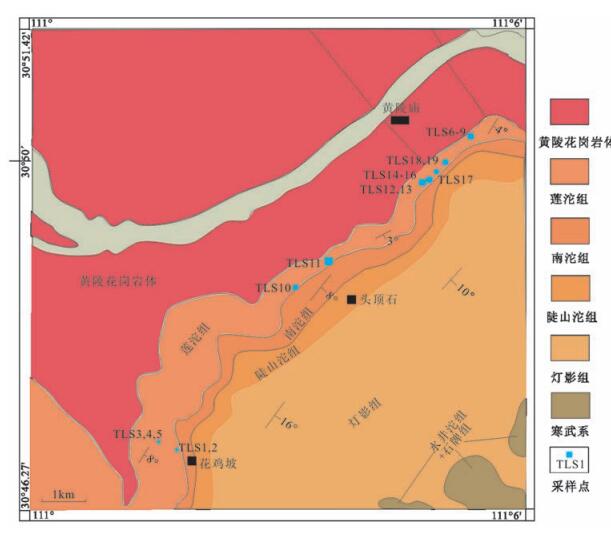
 下载:
下载:
